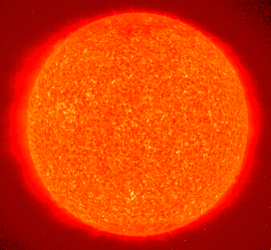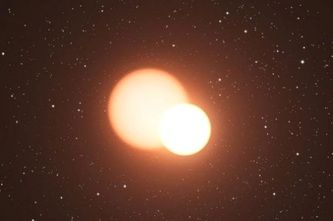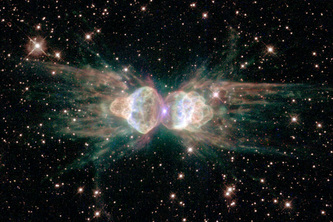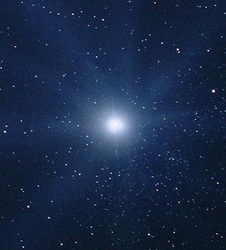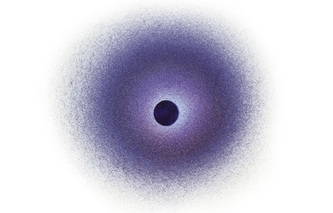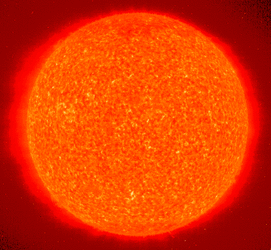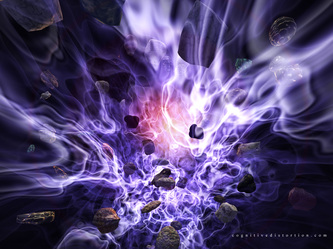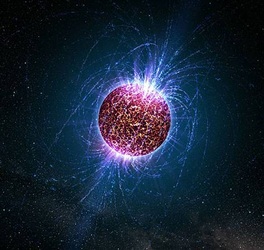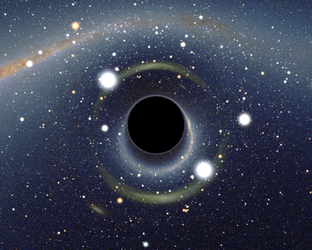The Death of Fomalhaut
Fomalhaut is expected to die in about a billion years, right now it is expected to be around 100-300 million years old which is a young star compared to many others including our Sun. It is suspected to die so soon because it is hotter and larger than the Sun, larger stars tend to not live as long as smaller stars because they fuse hydrogen into helium faster than small or average stars.
Probable Death Stages of Fomalhaut and Small to Average Size Stars
Click on Pictures to Enlarge
Red Giant Cepheid Variable (Smaller Object) Planetary Nebula White Dwarf Black Dwarf
Stage 1: Red Giant/Cepheid Variable
As the star ages, it begins to brighten and expand into a Red Giant or collapse into a Cepheid Variable. The star starts to swell and bloat up because fusion starts to decrease in the center of the star so the balance between the pushing out of fusion and the pulling of gravity are unequal. Nuclear fusion starts to decrease because there isn't a lot of hydrogen left to convert into helium. In the photo of a Cepheid Variable, the Cepheid Variable is the smaller object. In the picture it is aligned with another star.
Stage 2: Planetary Nebula
The next stage of Fomalhaut's probable death is when it forms a Planetary Nebula. A Planetary Nebula is the outer edges of a star that are shed away because they are cooled off from the star's decrease in nuclear fusion.
Stage 3: White Dwarf
The third death stage of Fomalhaut would be a White Dwarf. After the Planetary Nebula has been shed then the star is left with its core, which then becomes the entire star called a White Dwarf. There is no longer nuclear fusion going on within the star, it is just slowly cooling off.
Stage Four: Black Dwarf
As the White Dwarf cools it goes into its last stage of life, a Black Dwarf. Black Dwarfs are stars that are almost or completely cooled off. Black Dwarf stars are barely detectable and that is because it is not producing its own light anymore.
As the star ages, it begins to brighten and expand into a Red Giant or collapse into a Cepheid Variable. The star starts to swell and bloat up because fusion starts to decrease in the center of the star so the balance between the pushing out of fusion and the pulling of gravity are unequal. Nuclear fusion starts to decrease because there isn't a lot of hydrogen left to convert into helium. In the photo of a Cepheid Variable, the Cepheid Variable is the smaller object. In the picture it is aligned with another star.
Stage 2: Planetary Nebula
The next stage of Fomalhaut's probable death is when it forms a Planetary Nebula. A Planetary Nebula is the outer edges of a star that are shed away because they are cooled off from the star's decrease in nuclear fusion.
Stage 3: White Dwarf
The third death stage of Fomalhaut would be a White Dwarf. After the Planetary Nebula has been shed then the star is left with its core, which then becomes the entire star called a White Dwarf. There is no longer nuclear fusion going on within the star, it is just slowly cooling off.
Stage Four: Black Dwarf
As the White Dwarf cools it goes into its last stage of life, a Black Dwarf. Black Dwarfs are stars that are almost or completely cooled off. Black Dwarf stars are barely detectable and that is because it is not producing its own light anymore.
Probable Death Stages of a Large Star
Click on Pictures to Enlarge
Red Giant Supernova Neutron Star Black Hole
Stage 1: Red Giant or Supergiant
Large stars fuse their elements together at a faster rate then smaller stars because there is more pressure and they are larger. Because they fuse their elements together at a faster rate, they swell up at a faster rate and become Red Giants or Supergiants. In the Red Giants/Supergiants heavier elements are fused together such are carbon crushed into neon and magnesium, oxygen fuses into silicon and sulfur, and then the silicon and sulfur are turned into the iron core of the star.
Stage 2: Supernova
The star's core is now made of iron and will not fuse into other elements, all the hydrogen, helium, and other elements that would continue fusing are decreasing in availability. There is also less pressure in the star so it cannot fuse together elements to make other elements. This causes for the star to collapse on itself causing a supernova. During the supernova protons and electrons combine to form neutrons which creates high energy subatomic particles. These subatomic particles create shock waves that go the star's layers that make it turn really bright as well as destroy the iron core, as well as ejecting other elements everywhere.
Stage 3: Planetary Nebula
The third death stage of a large star would be a would be a Planetary Nebula. After the Supernova, all the materials that were exploded form a planetary nebula where the Red Giant or Supergiant once was.
Stage 4: Neutron Star or Black Hole
After the supernova, a possible final stage of a large star's life a neutron star. If it turns into a neutron star then the neutrons contract together because of gravity. They form a very dense but small star that only one teaspoon of the star would weigh 5 times 10^12 kilograms on Earth. The other possible last stage of a large star's life is a black hole. A black hole is theoretically formed when a colossal star cannot create the nuclear energy to support its own gravitational pull from its core. When this happens it snaps under its own gravity causing gravity to make the core implode. When anything gets too close it will be sucked into the black hole and it won't be able to come back or escape, even light.
Large stars fuse their elements together at a faster rate then smaller stars because there is more pressure and they are larger. Because they fuse their elements together at a faster rate, they swell up at a faster rate and become Red Giants or Supergiants. In the Red Giants/Supergiants heavier elements are fused together such are carbon crushed into neon and magnesium, oxygen fuses into silicon and sulfur, and then the silicon and sulfur are turned into the iron core of the star.
Stage 2: Supernova
The star's core is now made of iron and will not fuse into other elements, all the hydrogen, helium, and other elements that would continue fusing are decreasing in availability. There is also less pressure in the star so it cannot fuse together elements to make other elements. This causes for the star to collapse on itself causing a supernova. During the supernova protons and electrons combine to form neutrons which creates high energy subatomic particles. These subatomic particles create shock waves that go the star's layers that make it turn really bright as well as destroy the iron core, as well as ejecting other elements everywhere.
Stage 3: Planetary Nebula
The third death stage of a large star would be a would be a Planetary Nebula. After the Supernova, all the materials that were exploded form a planetary nebula where the Red Giant or Supergiant once was.
Stage 4: Neutron Star or Black Hole
After the supernova, a possible final stage of a large star's life a neutron star. If it turns into a neutron star then the neutrons contract together because of gravity. They form a very dense but small star that only one teaspoon of the star would weigh 5 times 10^12 kilograms on Earth. The other possible last stage of a large star's life is a black hole. A black hole is theoretically formed when a colossal star cannot create the nuclear energy to support its own gravitational pull from its core. When this happens it snaps under its own gravity causing gravity to make the core implode. When anything gets too close it will be sucked into the black hole and it won't be able to come back or escape, even light.
